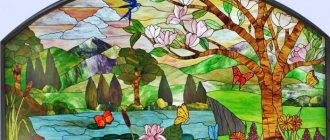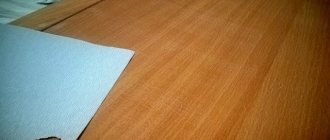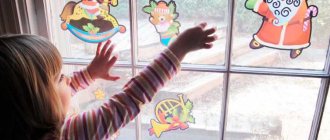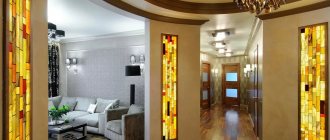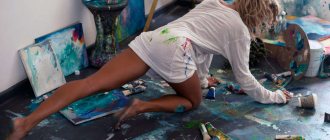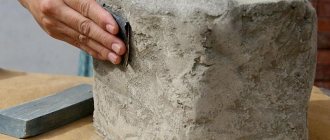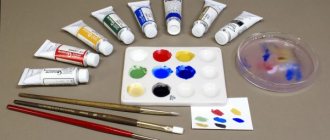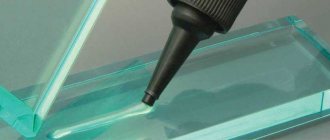Stained glass painting
Stained glass is an impressive sight, but, unfortunately, it is extremely rare in interiors today. The reason for this is its high cost and specific decor. True stained glass will not decorate every setting. The element that came to us from palace and church designs managed to maintain its fidelity to classicism. In order to prevent the unique design solution from becoming a complete rarity, the designers took up paints and imitated the technology, developing stained glass painting.
Stained glass painting
Nowadays, stained glass is often called not a canvas assembled from a multi-colored glass mosaic, but ordinary window glass painted with stained glass paints. The latter is much cheaper to produce, although visually it is practically indistinguishable from real stained glass. It is used in the design of premises in the Mediterranean, Art Nouveau, and Provence styles.
Visually, the painting is almost no different from real stained glass
Window frame with stained glass painting
When choosing a frame for a stained glass window, you need to focus on the type of window that will be installed, the temperature conditions of the region, and, of course, the budget. Moreover, today window manufacturers offer a huge range of window frames from various materials. Among the most popular are:
- wood;
- plastic (PVC);
- aluminum.
Details about frames for stained glass windows.
Installation of painted stained glass in a window
Today, stained glass with paintings can be installed in a window in three ways:
- Painted stained glass can be installed in a window frame by placing glass with stained glass painting, using putty and glazing beads instead of ordinary glass.
- “In the overlay” - the painted glass is attached to the sealant, on top of the window glass on the room side.
- In double glazing, instead of middle glass (3rd glass).
Details about fastening and installation of stained glass windows.
Weight and dimensions of a window with stained glass painting
Each window frame is designed to hold a certain number of glasses, with a certain weight, so accurately calculating the weight of the glass can prevent big problems. After all, excess load can not only cause deformation of the frame and the formation of cracks, but also contribute to the “falling out” of the frame from the window opening. If painted stained glass is installed instead of old window glass, then the total weight of the window structure will remain virtually unchanged. But if, for example, it is impossible to dismantle old glass from a window and it is assumed that the painted stained glass window will be installed in the form of additional glass “in the overlay,” then a lot depends on the weight of the additional glass.
Durability of stained glass painting on windows
Window painting has long been considered a worthy alternative to stained glass windows using classical techniques and Tiffany. Moreover, in some cases, preference is given to painted stained glass windows, since they open up enormous opportunities for the manifestation of one’s individualism and creative potential. The only thing in which stained glass window painting is inferior to real stained glass is durability. Even if you use the highest quality stained glass paints to apply a design to glass, the durability of such a stained glass window will still not exceed 15-30 years. You can slightly extend the service life of painted stained glass if you cover the patterns on the windows with a special protective varnish, but such a step will not radically affect the durability.
In order for the painted stained glass window to serve you for as long as possible, experts recommend using protective varnish and stained glass paints of the same brand.
The durability of painted stained glass windows can be guaranteed by the quality of stained glass paints, which do not fade, do not spread under the rays of the hot sun, do not crack from severe frosts, and are not afraid of moisture.
Choosing glass for stained glass painting
Selecting glass for stained glass painting is one of the most important stages in the manufacture of high-quality stained glass windows. You cannot save on glass, since the quality and appearance of stained glass depends on it.
Today, several types of glass are used for glazing windows. The most common are ordinary glass, tempered glass and triplex glass. Each of these glasses has both its disadvantages and advantages.
We see ordinary glass almost everywhere, and have long been accustomed to it. Everyone knows perfectly well that if you press a little harder on such glass, a crack, at best, is guaranteed. And if you hit ordinary glass, it will instantly shatter into very sharp and dangerous pieces. However, today it is one of the lightest types of glass that ordinary, non-reinforced frames can support.
Tempered glass is ordinary glass that has undergone a tempering process, which makes the glass impact and heat resistant. Tempered glass can withstand heavy loads and strong impacts. Even if the load turns out to be greater than calculated, the glass cracks and falls out of the frame in small fragments with blunt edges.
Triplex consists, as a rule, of two glasses connected to each other using liquid polymer (poured manufacturing technology) or polymer film (film manufacturing technology). Film triplex is more transparent, and cast triplex is stronger. Thanks to the adhesive polymer layer, both one and the second type of triplex, when destroyed, do not crumble into small fragments, but keep their shape. At the same time, armored glass for windows can be created from triplex.
Caring for a painted stained glass window
Painted stained glass windows are quite practical and do not require any special care. However, they “don’t like” being washed with abrasive agents. It is also not recommended to wash them using detergents that contain alcohol and solvent.
It should also be remembered that stained glass paint, even heat-treated, is very sensitive to various mechanical damage (for example, scratches or chips). Therefore, if possible, try to limit access to stained glass windows for children and pets.
Otherwise, caring for painted stained glass is no different from caring for ordinary window glass. Contaminants can be washed off with warm water and mild detergents (such as soap).
Even if a scratch appears on a painted stained glass window, do not worry. Painted stained glass windows can be easily restored - you just need to “finish” the scratched area.
Choosing a pattern for a painted stained glass window
A painted stained glass window will perfectly complement any room, the main thing is to choose the right color and pattern. Of course, when choosing a design, you must first of all focus on your own tastes. However, it is also necessary to carefully consider the design so that the window not only gives visual pleasure, but also emphasizes the overall style of the room.
Painted stained glass windows will look very impressive and original if they are supported with thematic drawings on other interior items, for example, on furniture facades or a mirror.
Drawing with stained glass paints can be anything from watercolor techniques to imitation of classical stained glass.
You can find out more about where else the stained glass painting technique is used, what stylistic solutions are more typical for it and in what interiors it is best to use it, in the menu below:
By application »
In furniture »
Indoors »
By style »
- Paintings
- Window
- Doors
- Ceilings
- Partitions
Advantages and disadvantages of painted stained glass windows
The main advantage of painted stained glass windows is, of course, their special expressiveness and handmade work, which is valued above all else. However, the list of advantages of this type of stained glass art does not end there. We cannot remain silent about the fact that the technique of painting on glass:
- Makes it possible to draw any design on the window glass (including original drawings and reproductions of famous paintings).
- Makes the window exclusive and unique.
- Allows you to artistically design windows of any shape and size.
- Opens up unlimited possibilities for creating unusual and original interiors.
If we talk about the disadvantages of painted stained glass windows, then it is worth noting the following:
- the painted stained glass window has both a front and a back side;
- Compared to real stained glass, painted stained glass is not durable.
Cost of painted stained glass on a window
A painted stained glass window on a window is nothing more than a picture painted by an artist, only not on canvas, but on glass. Therefore, when determining the cost, not only consumables and labor costs are taken into account, but also the artist’s skill. After all, when purchasing a painting, the buyer pays not for paints and canvas, but for a hand-made work into which the master put his thoughts and soul. That is, when determining the price for painted stained glass, factors such as:
- the area of glass on which painting will be done;
- complexity of the drawing;
- artist's skill;
- quantity, variety and quality of paints used;
- if the glass is painted with firing paints - heat treatment of the paints.
For more information about the factors influencing the cost of the order, see the section stained glass windows - prices.
Stencil design on glass
This technique will greatly help those who are not able to draw beautifully. Stencils for painting on glass will help you decorate the surface evenly and neatly. Interesting stamped designs are offered in stores specializing in goods for creativity and decoration. It’s quite possible to make simple preparations yourself. Picture ideas for glass painting can be searched on the Internet.
Stencil for painting on glass
Stencils are:
- disposable;
- reusable.
The former are made of paper or cardboard, the latter are made of self-adhesive polymer film. We'll look at how to use stencils for painting on glass below.
Tips for choosing stained glass paints and making them yourself
Stained glass paints
Related article: How can you quickly level the floor in a room?
Before you paint with stained glass paints, you need to choose them correctly. Today, there are 2 types of paints available in stores: without firing and with firing. The latter option requires heat treatment after application. An oven with a temperature range from 100 to 150 degrees is suitable for this.
Arbitrary drawings on glass
“The pattern on glass can be applied for a long time or for a short period”
Do-it-yourself glass painting is a great opportunity to make your interior unique. You can paint the glass surface in any way you like, the main thing is that the picture and color scheme correspond to the general interior mood of the room.
A pattern on glass will make the interior unique
The pattern on glass can be applied for a long time or for a short period. In the latter case, they paint with easily washable paints and do not resort to protective fixation of the image. This is often done on the eve of any celebrations. For example, it is customary to paint windows and door glass on the eve of the New Year holidays. Beautiful pictures chosen for glass painting will help create the appropriate atmosphere in the room.
Temporary New Year's glass painting
Step-by-step instructions for making stained glass
Painting windows with stained glass paints
Drawing on glass will not cause any difficulties if you follow the following instructions:
- The selected base for painting must be thoroughly washed.
- The dried surface should be degreased. To do this, take alcohol and a cloth napkin or a piece of cotton wool. The glass surface is treated with any of the proposed compositions.
- The next step will be choosing a future painting or drawing. The selected stencil is outlined with a permanent marker. Such a marker can be easily removed later using regular alcohol.
- The next step is to draw the outline of the design in black using acrylic paint.
Expert advice! When performing this type of work, it is worth remembering that all contours must be closed. This will prevent the fill from spreading in the subsequent drawing.
- The applied outline of the painting on the glass must dry completely. When using any acrylic contour, drying will take no more than 2 - 3 hours.
- The next step is to paint the middle of the picture. Each paint color must dry completely to prevent them from merging. In case the paint is applied incorrectly, you need to use cotton pads or sticks and nail polish.
Stained glass paints for bedroom interiors
Expert advice! When changing paint colors, you must thoroughly wash your brushes. To do this, use nail polish and a cloth again. The washed brush should be completely dried with a cloth.
- When the drawing is completely filled with paints, you can proceed to drying it. Many experts advise drying glass naturally. If there is a need to speed up this process, you can use a hairdryer. But it is worth remembering that such a pattern may subsequently crack or darken if the heat treatment is excessive.
- You can complete a glass painting with nail polish. Simply apply a layer and let it dry completely.
Related article: Roof ventilation. Roof ventilation system options
How is glass and ceramic painting done?
“Nitro-oil paints are considered the most relevant and designed for a long service life, they apply perfectly, adhere perfectly to the design on glass and have virtually no flaws”
There are factory-made and home-made paints for painting glass. There are 4 known homemade compounds. The simplest and most unstable is made from aniline and PVA. Aniline can be mixed with gelatin. The effect will not be much better, since stained glass paint will quickly fade in direct sun, but if you need to get an ideal quality meniscus, it has no equal.
Paint for painting on glass
The inherited Soviet-rare recipe includes BF-2 glue and ballpoint pen paste. Nitro-oil paints are considered the most relevant and designed for a long service life, they apply perfectly, adhere perfectly to the design on glass and have practically no flaws.
Preparing PVA-aniline
To prepare PVA-aniline paint for painting on glass and ceramics, you will need to prepare the ingredients: dilute 100 ml of adhesive base twice with distilled water and dissolve the aniline dye powder according to the instructions. The resulting dye solution is filtered through a thin nylon. Now it's time to play with shades. Aniline is added dropwise to the adhesive emulsion. The color saturation is checked on the glass. You will have to add pigment to under-tinted stained glass paint, and adhesive emulsion to saturated stained glass paint.
You can make paints on glass yourself
Preparing the gelatin-aniline mixture
200 ml of distillate is heated to 50°C, after which 6 g of ordinary gelatin is diluted in it. The aniline mixture is prepared according to the method described above. The dye is also added to the cooled gelatin in drops under regular monitoring of the level of paint saturation with it. Stained glass painting made with this composition can have increased wear resistance.
Gelatin-aniline paint has increased wear resistance
After drying, it is enough to cover the drawing on the glass with colorless acrylic varnish. Do not try to repeat this with PVA-aniline stained glass paints. They are not designed for such delights and will simply float.
Preparing a Soviet recipe
The required amount of BF-2 is dissolved in double the volume of acetone. The core paste is added dropwise to the resulting solution. The mixture must be thoroughly mixed. Whether the desired shade has been obtained is also checked using glass.
Paint with core paste
Preparing the nitro-oil composition
The proportionality of this mixture is 60x40, where 60% of the volume will be occupied by transparent furniture nitro varnish, and 40% will remain with 647 solvent. You need to add color to the composition using artistic oil paints. Since this is a paste-like composition, it is dosed based on the size of a pea. After kneading thoroughly, the combination is checked to ensure it matches the shade.
Nitro-oil composition can be varnished
Painting on glass with stained glass paints of this type can also be covered with a layer of varnish. This will make the product even more aesthetically pleasing.
Ready-made glass paints can be:
- universal;
- water based;
- glossy;
- acrylic;
- stained glass.
Universal
These are paints for glass and ceramics. They can also be used to paint faience and polystyrene, plexiglass and all kinds of plastic. The compositions are perfectly composed. Drawings on glass retain the contrast of shades for a long time and are not washed off with water. Not suitable for painting food utensils.
Universal paints are not washed off with water
Water based
Most often, such paints are needed for painting glass located in a humid microclimate. Firing is required to fix them on the surface. After this treatment, the paints of the design on the glass are not afraid of even repeated mechanical washing in the dishwasher. In addition to everything, they are completely non-toxic, therefore they are allowed in painting utensils used in everyday life.
Water-based paints are suitable for painting dishes
Glossy
Paints can be mixed with each other. The pictures they draw are distinguished by their brightness, depth of shades, and pleasant shine. Apply in two layers. Each one takes at least two days to dry. Glass painting will require varnish protection.
Glossy paints are bright
Acrylic
Quick-drying paints with good adhesion, used both for creating conventional drawings and for stained glass painting. Extremely resistant. They do not fade or fade. The drawings they make are matte. They belong to the universal category, since the paints can be used for painting on both glass and ceramics.
Acrylic paints do not fade or fade
Stained glass
This type of paint is divided into fired and unfired.
Burnt
After application, the design on the glass must be fired in the oven. This is not always acceptable for large panels, for example. What to do in this case? Just leave the painting to dry on its own, putting it in a secluded corner. In a week you will receive a full-fledged product. Look at the photo to see what this glass painting will look like. The main thing here is not to let the outlines of the picture blur, and not to blur the lines, because unfired paints will be vulnerable for a long time.
Stained glass paints with firing
Unfired
These stained glass paints are bright, but their application techniques are more complex. Selected pictures for glass painting are drawn in stages. First, the outline of the future masterpiece is drawn, and only then the free spaces are filled. This is also a long-lasting, drying type of stained glass paint, and each variation will have individual timing for this. Painting on glass and ceramics is protected with a layer of varnish. The durability of paints varies, but no matter what the design, it cannot be soaked, much less subjected to mechanical cleaning.
Drawing on glass with stained glass paints
If you look at the examples of glass painting in the photo, you can see that in addition to color spots, there are many thin lines on them. To obtain them in glass painting, markers and outlines are used.
Markers
Helps in drawing fine lines. The water base allows them not to spread on glossy surfaces. After applying the design to the glass, the product is sent for firing.
Glass markers
Outlines
Relief contours have the form of applicators with a narrow tip, which is very convenient for applying thin, even lines.
Contours are very convenient for drawing fine lines
Multilayer technique
The essence of this painting technique is clear from its name: paint is applied in several layers. Moreover, depending on what effect the artist wants to achieve, the bottom layer (or several layers) can be either completely dry or of varying degrees of dampness, so that they are mixed with the layer applied above.
This technique allows you to create the most realistic images using stained glass paints; with its help you can even convey shadows and the play of light. This technique requires a lot of attention and patience.
Water-based stained glass paints are best suited for this technique. Although, if you practice enough, you can achieve good results with varnish stained glass paints.
A short review of brands and manufacturers of organic-based stained glass paints (varnish) will help you make the right choice when purchasing.
Here, look at the example of the work of one master of stained glass painting, where you can clearly see the transitions of light and shadow on the boy’s face and on the bodies of the angels.
Examples of stained glass multilayer technique
Consistency in work and accuracy are important here... If errors appear, it will be difficult to correct them. And I repeat again - try, experiment! After all, nothing is impossible - anyone can master such a subtle technique... the main thing here is desire!
What can you paint on glass?
Drawing on glass is relevant wherever there is a suitable surface area for its application. A wonderful addition to a painted glass door insert would be a similarly designed lampshade for a wall sconce, floor lamp or ceiling lamp. You can decorate the interior with stained glass paintings. Glass painting in niches and on partitions looks good. Ceilings are often decorated with stained glass inserts.
Ceiling decor with stained glass inserts
Glass painted to look like stained glass can become a decorative element for stairs in two-level apartments; it is inserted between wooden or stainless steel balusters. Painting on glass with stained glass paints will decorate kitchen units, shower stalls, and wardrobe doors.
Drawing on glass in the kitchen interior
What is stained glass?
Stained glass painting is the process of applying paint to glass or ceramics. The first stained glass windows originated hundreds of years ago and throughout their history they have lost and then regained popularity. In this article we will talk in detail about how stained glass art originated and developed, and also describe in detail the technology for creating stained glass.
History of stained glass painting
The first stained glass windows, judging by the written sources found, appeared in the 12th century. To create them, a special paint was used, consisting of a mixture of copper and iron with glass. It was diluted and used for painting on glass.
In the Middle Ages, stained glass painting was only in churches. Bright reflections and play of colors immersed people in an atmosphere of mystery and awe. The Gothic style also developed stained glass art - increasing window openings and creating new round windows, which allowed glass artists to show all their imagination and rich imagination.
In Rus', stained glass painting was not popular for two reasons:
- The church prohibited painting biblical characters on glass.
- Industry in Rus' lagged behind European industry.
Soon, stained glass painting ceased to be exclusively church. The Renaissance became the peak of popularity for stained glass art. It was ordered to decorate secular buildings and houses of wealthy citizens.
However, the glory of stained glass was short-lived. The religious wars of the 16th century, and after the Enlightenment, influenced its demand. At that time, art strived for transparency, and stained glass windows in the church, on the contrary, darkened the room. Therefore, all those few stained glass windows that remained after the hostilities were destroyed, and ordinary glass was put in their place.
The 18th and 19th centuries revived the art of stained glass. Russia also began to take an interest in him. However, the level of industrial development has not yet allowed the creation of stained glass.
For this reason, a stained glass window with the image of the Savior was commissioned to decorate St. Isaac's Cathedral in Germany, which is still considered one of the most beautiful in the world.
In the middle of the 19th century, Emperor Nicholas I ordered the construction of a glass factory, and since then stained glass windows have been created in our country.
In the 20th century, interest in stained glass faded again. This is due to the Art Nouveau style, which gravitated more towards the art of panels than to glass painting. However, the end of the 20th century revived stained glass, and it still remains one of the most popular types of decor.
DIY glass painting
Let's start considering the issue with the use of stencils in glass painting. Many of the simplest models can be made at home. To do this, you don’t even have to draw something: just find a suitable picture for painting on glass from a photo on the Internet and print it. A stationery knife will help you cut out the parts evenly. If you have to paint the glass of several windows or doors, then it is better, of course, to buy a reusable template.
A stationery knife will help you cut out the details of the stencil.
How to use a stencil
To paint glass using this technique, you will need stained glass or acrylic paints. Depending on the type of pattern being reproduced, you can work with a brush or sponge. Choosing a picture to paint on glass is a purely personal matter. What you need for work:
- the glass product itself;
- degreasing liquid;
- glass paint;
- tassels;
- scotch;
- stencil.
Stage I. Degrease the surface. This is a must. The glass must be free of stains and dirt so that paint can be applied evenly. You can prepare the surface by treating it with a cotton pad moistened with alcohol.
Surface degreasing
Stage II. We apply the stencil to the glass and, if necessary, fix it with tape. Fixing will make it motionless, which will eliminate errors in operation.
Fixing the stencil
Stage III. Let's start painting on glass with stained glass paints. Foam rubber or a cotton swab is dipped into the paint and distributed over the stencil voids using blotting movements.
Finished painting
Dot painting technique
To work you will need contour paints. Ideally, it is not a full-color, but a contour drawing on the glass that is reproduced. Points of identical size and at an even distance from each other are placed along the outline lines. The large elements of the selected picture are drawn first, and then the small details. The size of the dot is adjusted by the force of pressing on the tube.
Dot pattern on glass
Contour technique
A method that allows you to obtain the most expressive and colorful designs on glass. For detailed drawing use thin brushes or contour paints.
Contour painting technique
After the workpiece has dried, you can begin painting the inner contour voids. The work will require accuracy. The paints should not spread or go beyond the already outlined boundaries. Photos will demonstrate how to correctly perform this stage of glass painting.
Stained glass painting technique
A job that requires some skill. Stained glass paints are liquid and prone to spreading. For the idea to be a success, you must first mark the contours of the abstraction, covering the surface of the glass with a network of golden, black or silver lines. You need to draw them carefully, avoiding omissions and interruptions of lines. Remember that the contours will later play the role of barriers that do not allow colored paints to spread.
Stained glass painting
The blank for stained glass painting must dry thoroughly, and only after that it can be used again. When the drawing is completely ready and dried, the resulting panel is opened with varnish.
Filled stained glass
The pattern on glass obtained by this method of application is practically indistinguishable from real stained glass. But this will only happen if skillful hands also include an understanding of the intricacies of picture lighting. This will require specific refraction of the rays, which a reflective substrate can provide. This explains why the technique is more often used to decorate mirror surfaces.
Filled stained glass window with paints
When poured well, stained glass paint forms a meniscus. Rays of different curvatures of refraction passing through it make the stained glass window play with colored tints. Since diffraction also affects the boundaries of the border, it makes sense to make the border dark and shiny. How glass painting will look at this stage, look at the photo.
Filled stained glass painting on glass
Filled stained glass is made according to the following algorithm. First of all, the assembly table is prepared. Its surface is covered with white flannel, calico, and flannel. A stencil of the design is placed on the fabric, which is covered with pre-skimmed glass. Now you need to fix the workpiece along the contour. This is done with dishware PVA. The glass is left to dry for a day. After this, the most difficult part of the procedure for painting glass with stained glass paints will begin - filling the resulting cells. They are filled in one by one. Allowing each poured batch to dry.
Filling cells with paint
If a leak occurs, it can be carefully removed by scraping with a razor blade. The last cell of the stained glass window should be left to dry for another day. Then the resulting drawing on glass can be inserted into a frame or metal frame, if it was a panel, and sent to the place allocated to it.
It is worth dwelling in more detail on the pouring technique when painting on glass with stained glass paints. The cells are painted over with a brush soaked in the composition or filled with a syringe, distributing it along the contour. At the same time, touching the curb is strictly prohibited. The paint should spread into the meniscus on its own, naturally. If its concentration turns out to be liquid, then after drying the cell is flooded again. It is strictly forbidden to pour or add paint into the center. If painting on glass is done with your own hands and the process needs to be adjusted, then to thicken the color spot, experts recommend making two fills into the frame at once - along the inner and outer contour. Provided that a “blyamba” is formed in the center of the cell, the light refraction will be disrupted and the stained glass painting will lose its meaning. If there are many such punctures, the pattern on the glass will take on a sloppy appearance and you will not see the intended effect.
Filling the outline with a brush
Marbling
Another interesting and quick way to paint glass. Special glass paints of different shades are poured alternately in a thin stream into the center of a container filled with heated water. The resulting colored circles are stretched into a pattern with a toothpick. The object to be decorated is dipped into the prepared font.
Marbling glass
After extraction, an abstract drawing will remain on its surface. The picture will closely resemble the structure of marble. The paint is allowed to dry and the design is fixed on the glass with varnish. This way you can decorate glasses, bottles, dishes, small lampshades, and mini-panels.
Decoration of the stem of a glass by marbling
Non-contour technology
The peculiarity of stained glass paints is that they spread strongly over the glass. If you use them without contours, you need to control this spreading and, in fact, create a picture precisely due to it.
When applied, paints not only spread, but also mix with each other, creating new shades, stains and unclear boundaries. It turns out a little like a typical watercolor, only varnished.
Here is an example of stained glass abstraction, this is a blank for continuing the painting
This technique is more difficult than the previous one and takes a long time to master. It varies greatly depending on the brand of paint and the degree of dilution, and the application itself is difficult and time-consuming.
By the way, if you have not yet decided what stained glass paints you would like to use to paint your products, then a review article on stained glass paints can help you with this.
In general, this is a technique for curious people. It is best to use varnish stained glass paints to create beautiful paintings using the non-contour technique; they open up more opportunities in the world of stained glass painting.
By the way, these two techniques can be combined. For example, inside a large element in an outline you can make a pattern in a non-outline manner. And of course, flowers turn out especially beautiful when the spreading of stained glass paints creates amazing patterns inside the flower!
In a master class on painting a glass table, I show all the nuances of such work. The photo below clearly shows how beautiful spreading is created in this way.
Fragment from a lesson on painting a table
You can purchase a video tutorial on stained glass painting a glass table Also in this lesson I additionally show the technique of gilding with gold leaf, since gilding complements this work.
As you know, hand made is a special type of creativity and it is popular all over the world, because many people like to decorate the interior with their own hands.
